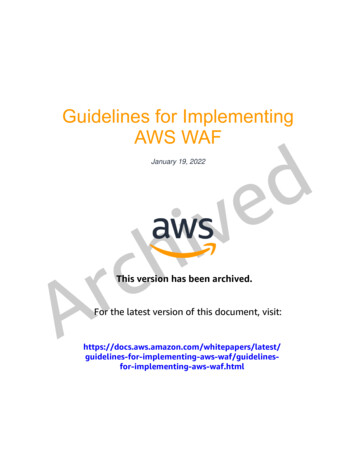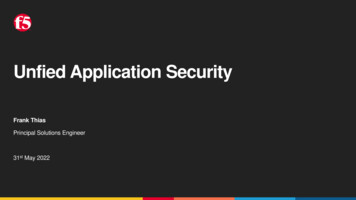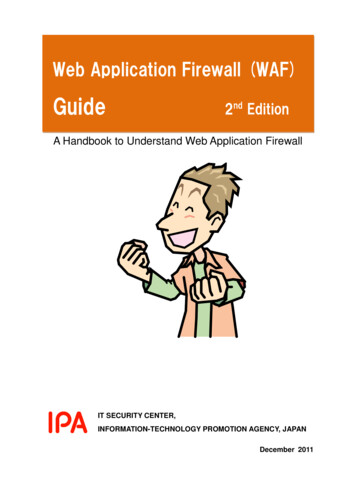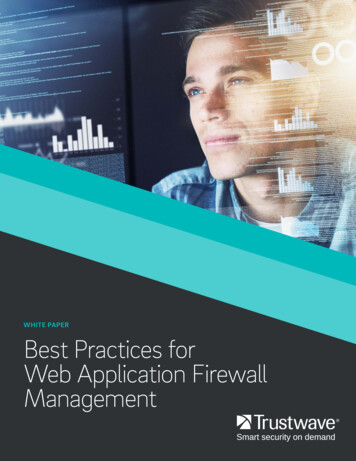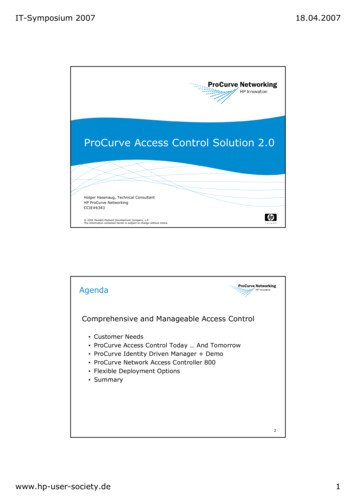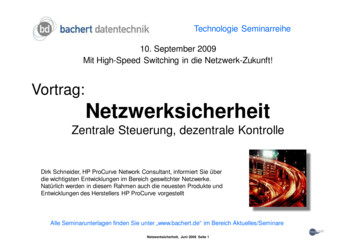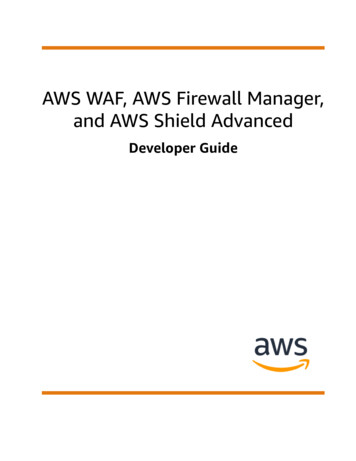
Transcription
AWS WAF, AWS Firewall Manager,and AWS Shield AdvancedDeveloper Guide
AWS WAF, AWS Firewall Manager, andAWS Shield Advanced Developer GuideAWS WAF, AWS Firewall Manager, and AWS Shield Advanced: DeveloperGuideCopyright Amazon Web Services, Inc. and/or its affiliates. All rights reserved.Amazon's trademarks and trade dress may not be used in connection with any product or service that is notAmazon's, in any manner that is likely to cause confusion among customers, or in any manner that disparages ordiscredits Amazon. All other trademarks not owned by Amazon are the property of their respective owners, who mayor may not be affiliated with, connected to, or sponsored by Amazon.
AWS WAF, AWS Firewall Manager, andAWS Shield Advanced Developer GuideTable of ContentsWhat are AWS WAF, AWS Shield, and AWS Firewall Manager? . 1AWS Shield . 2AWS Firewall Manager . 2Which should I choose? . 2. 2Setting up . 3Step 1: Sign up for an AWS account . 3Step 2: Create an IAM user . 3Step 3: Download tools . 5AWS WAF . 6How AWS WAF works . 6AWS WAF Web ACL capacity units (WCU) . 7Getting started with AWS WAF . 8Step 1: Set up AWS WAF . 8Step 2: Create a Web ACL . 9Step 3: Add a string match rule . 9Step 4: Add an AWS Managed Rules rule group . 10Step 5: Finish your web ACL configuration . 11Step 6: Clean up your resources . 11Managing and using a web access control list (web ACL) . 12How AWS resources handle response delays from AWS WAF . 13Web ACL rule and rule group evaluation . 13Deciding on the default action for a web ACL . 15Working with web ACLs . 16Rule groups . 25Managed rule groups . 26Managing your own rule groups . 61Rule groups from other services . 62Rules . 63Rule name . 64Rule action . 64Rule statements . 65Web request body, headers, and cookies . 91IP sets and regex pattern sets . 93Creating and managing an IP set . 93Creating and managing a regex pattern set . 95Customized web requests and responses . 97Custom request header insertions . 98Custom responses . 99Supported status codes . 102Labels on web requests . 103How labeling works . 104Syntax and naming requirements . 104Adding a label . 106Matching against a label . 106Label match examples . 107Managed protections . 110Bot Control . 110Account takeover prevention . 123Application integration . 131AWS WAF CAPTCHA . 141Logging web ACL traffic . 147Pricing for logging web ACL traffic information . 147AWS WAF logging destinations . 148iii
AWS WAF, AWS Firewall Manager, andAWS Shield Advanced Developer GuideManaging logging for a web ACL .Log Fields .Log Examples .Listing IP addresses blocked by rate-based rules .How AWS WAF works with Amazon CloudFront features .Using AWS WAF with CloudFront custom error pages .Using AWS WAF with CloudFront geo restriction .Using AWS WAF with CloudFront for applications running on your own HTTP server .Choosing the HTTP methods that CloudFront responds to .Security .Data protection .Identity and access management .Logging and monitoring .Compliance validation .Resilience .Infrastructure security .AWS WAF quotas .Migrating your AWS WAF Classic resources to AWS WAF .Why migrate to AWS WAF? .How the migration works .Migration caveats .Migrating a web ACL .AWS WAF Classic .Setting up AWS WAF Classic .Step 1: Sign up for an AWS account .Step 2: Create an IAM user .Step 3: Download tools .How AWS WAF Classic works .AWS WAF Classic pricing .Getting started with AWS WAF Classic .Step 1: Set up AWS WAF Classic .Step 2: Create a Web ACL .Step 3: Create an IP match condition .Step 4: Create a geo match condition .Step 5: Create a string match condition .Step 5A: Create a regex condition (optional) .Step 6: Create a SQL injection match condition .Step 7: (Optional) create additional conditions .Step 8: Create a rule and add conditions .Step 9: Add the rule to a Web ACL .Step 10: Clean up your resources .Creating and configuring a Web Access Control List (Web ACL) .Working with conditions .Working with rules .Working with web ACLs .Working with AWS WAF Classic rule groups for use with AWS Firewall Manager .Creating an AWS WAF Classic rule group .Adding and deleting rules from an AWS WAF Classic rule group .Getting started with AWS Firewall Manager to enable AWS WAF Classic rules .Step 1: Complete the prerequisites .Step 2: Create rules .Step 3: Create a rule group .Step 4: Create and apply an AWS Firewall ManagerAWS WAF Classic policy .Tutorial: Creating a AWS Firewall Managerpolicy with hierarchical rules .Step 1: Designate a Firewall Manager administrator account .Step 2: Create a rule group using the Firewall Manager administrator account 262263263263264265266266
AWS WAF, AWS Firewall Manager, andAWS Shield Advanced Developer GuideStep 3: Create a Firewall Manager policy and attach the common rule group .Step 4: Add account-specific rules .Conclusion .Logging Web ACL traffic information .Listing IP addresses blocked by rate-based rules .How AWS WAF Classic works with Amazon CloudFront features .Using AWS WAF Classic with CloudFront custom error pages .Using AWS WAF Classic with CloudFront geo restriction .Using AWS WAF Classic with CloudFront for applications running on your own HTTP server .Choosing the HTTP methods that CloudFront responds to .Security .Data protection .Identity and access management .Logging and monitoring .Compliance validation .Resilience .Infrastructure security .AWS WAF Classic quotas .AWS Firewall Manager .AWS Firewall Manager pricing .AWS Firewall Manager prerequisites .Step 1: Join and configure AWS Organizations .Step 2: Set the AWS Firewall Manager administrator account .Step 3: Enable AWS Config .Step 4: For Cloud NGFW, subscribe in the AWS Marketplace, and configure third-party settings .Step 5: For Network Firewall and DNS Firewall policies, enable resource sharing .Step 6: To use AWS Firewall Manager in Regions that are disabled by default .Managing the Firewall Manager administrator .Changing the account .Disqualifying changes to the account .Getting started with AWS Firewall Manager policies .Getting started with AWS Firewall Manager AWS WAF policies .Getting started with AWS Firewall Manager AWS Shield Advanced policies .Getting started with AWS Firewall Manager Amazon VPC security group policies .Getting started with AWS Firewall Manager Network Firewall policies .Getting started with AWS Firewall Manager DNS Firewall policies .Getting started with AWS Firewall Manager Cloud NGFW policies .Working with AWS Firewall Manager policies .General settings .Creating a policy .Deleting a policy .Policy scope .Managed lists .AWS WAF policies .AWS Shield Advanced policies .Security group policies .Network Firewall policies .Palo Alto Networks Cloud NGFW policies .DNS Firewall policies .Resource sharing for Network Firewall and DNS Firewall policies .Viewing resource compliance .Firewall Manager findings .AWS WAF policy findings .Shield policy findings .Security group common policy findings 61361362363366366367367
AWS WAF, AWS Firewall Manager, andAWS Shield Advanced Developer GuideSecurity group content audit policy findings .Security group usage audit policy findings .DNS Firewall policy findings .Security .Data protection .Identity and access management .Logging and monitoring .Compliance validation .Resilience .Infrastructure security .AWS Firewall Manager quotas .Mutable quotas .Immutable quotas .AWS Shield .How Shield works .AWS Shield Standard overview .AWS Shield Advanced overview .Examples of DDoS attacks .How Shield detects events .Examples of DDoS resilient architectures .DDoS resiliency example for web applications .DDoS resiliency example for TCP and UDP applications .Example Shield Advanced use cases .Getting started .Subscribe to Shield Advanced .Add and configure protections .Configure SRT support .DDoS dashboard in CloudWatch and CloudWatch alarms .SRT support .Configuring access for the Shield Response Team (SRT) .Configuring proactive engagement .Contacting the SRT .Resource protections .Protections by resource type .Application layer (layer 7) protections .Configuring health-based detection using health checks .Managing resource protections .Protection groups .Tracking protection changes .Visibility into DDoS events .Global and account activity .Events .Metrics .Event visibility across accounts .Responding to DDoS events .Contacting support for an application layer attack .Manually mitigating an application layer attack .Requesting a credit after an attack .Security in your use of the Shield service .Data protection .Identity and access management .Logging and monitoring .Compliance validation .Resilience .Infrastructure security .AWS Shield Advanced quotas .Monitoring 440441453454454454455456
AWS WAF, AWS Firewall Manager, andAWS Shield Advanced Developer GuideMonitoring tools .Automated tools .Manual tools .Monitoring with Amazon CloudWatch .Logging API calls with AWS CloudTrail .AWS WAF information in AWS CloudTrail .AWS Shield Advanced information in CloudTrail .AWS Firewall Manager information in CloudTrail .Using the AWS WAF and AWS Shield Advanced API .
AWS WAF, AWS Firewall Manager, and AWS Shield Advanced Developer Guide
